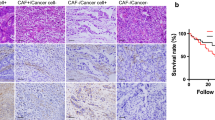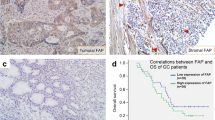Abstract
Objective
To investigate the inhibitory effects of paeoniflorin on migration- and invasion-promoting capacities of gastric cancer associated fibroblasts (GCAFs) and to explore the molecular mechanism underlying the effects.
Methods
Paired gastric normal fifbroblast (GNF) and GCAF cultures were established from resected tissues. GCAFs were treated with control medium, or 2.5, 5 or 10 μg/mL paeoniflorin. Conditioned media were prepared from GNFs, GCAFs, control-treated GCAFs and paeoniflorin-treated GCAFs, and used to culture AGS human gastric cancer cells. The migration and invasion capacities of AGS cells were determined with wound healing test and transwell invasion assay, respectively. The interleukin 6 (IL-6) mRNA and microRNA-149 expression in GCAFs were detected by reverse transcription-quantitative polymerase chain reaction. The IL-6 protein expression and secretion by GCAFs were measured with Western blot and enzyme-linked immunosorbent assay analysis, respectively. The protein levels of phosphorylated signal transducer and activator of transcription 3 (STAT3), matrix metalloproteinase (MMP) and MMP9 in AGS cells were examined by Western blot.
Results
GCAFs displayed enhanced capacities to induce AGS cell migration and invasion as compared with GNFs. Paeoniflorin treatment significantly inhibited the migration- and invasion-promoting capacities of GCAFs (P<0.05). GCAFs produced and secreted more IL-6 into the conditioned medium than GNFs, leading to over-activation of STAT3-MMP signaling in AGS cells. Paeoniflorin suppressed IL-6 production and secretion by up-regulating microRNA149 expression in GCAFs, and subsequently prevented GCAFs from activating IL-6-STAT3-MMP signaling of AGS cells.
Conclusions
Paeoniflorin inhibits the migration- and invasion-promoting capacities of GCAFs by targeting microRNA-149 and IL-6. Paeoniflorin is potentially a novel therapeutic agent against cancer microenvironment.
Similar content being viewed by others
References
Søreide K, Sandvik OM, Søreide JA, Giljaca V, JureckovaA, Bulusu VR. Global epidemiology of gastrointestinal stromal tumours (GIST): a systematic review of population-based cohort studies. Cancer epidemiol 2016;40:39–46.
Oue N, Aung PP, Mitani Y, Kuniyasu H, Nakayama H. Genes involved in invasion and metastasis of gastric cancer identified by array-based hybridization and serial analysis of gene expression. Oncology 2005;69 Suppl 1:17–22.
Wei SC, Fattet L, Yang J. The forces behind EMT and tumor metastasis. Cell Cycle 2016;14:2387–2388.
Ben-David U. Genomic instability, driver genes and cell selection: Projections from cancer to stem cells. Biochim Biophys Acta 2015;1849:427–435.
Huang S. Genetic and non-genetic instability in tumor progression: link between the fitness landscape and the epigenetic landscape of cancer cells. Cancer Metastasis Rev 2013;32:423–448.
Holohan C, Van Schaeybroeck S, Longley DB, Johnston PG. Cancer drug resistance: an evolving paradigm. Nat Rev Cancer 2013;13:714–726.
Han Y, Zhang Y, Jia T, Sun Y. Molecular mechanism underlying the tumor-promoting functions of carcinomaassociated fibroblasts. Tumour Biol 2015;36:1385–1394.
Hu C, Wang Z, Zhai L, Yang M, Shan L, Chai C, Liu M, Wang L. Effects of cancer-associated fibroblasts on the migration and invasion abilities of SGC-7901 gastric cancer cells. Oncol Lett 2013;5:609–612.
Shimoda M, Mellody KT, Orimo A. Carcinoma-associated fibroblasts are a rate-limiting determinant for tumour progression. Semin Cell Dev Biol 2010;21:19–25.
Du Q, Xu XH, Lin PC, Lu YC, Ye J. Research progress and developmental prospect of plant polysaccharide. E-J Transl Med 2017;4:78–82.
Wang ZF, Ma DG, Wang CS, Zhu Z, Yang YY, Zeng FF, et al. Triptonide inhibits the pathological functions of gastric cancer-associated fibroblasts. Biomed Pharmacother 2017;96:757–767.
Ye S, Mao B, Yang L, Fu W, Hou J. Thrombosis recanalization by paeoniflorin through the upregulation of urokinase-type plasminogen activator via the MAPK signaling pathway. Mol Med Rep 2016;13:4593–4598.
Zhang LL, Wei W, Wang NP, Wang QT, Chen JY, Chen Y, et al. Paeoniflorin suppresses inflammatory mediator production and regulates G protein-coupled signaling in fibroblast-like synoviocytes of collagen induced arthritic rats. Inflamm Res 2008;57:388–395.
Yang J, Yan Y, Liu H, Wang J, Hu J. Protective effects of acteoside against X-ray-induced damage in human skin fibroblasts. Mol Med Rep 2015;12:2301–2306.
Wang ZF, Ma DG, Zhu Z, Mu YP, Yang YY, Feng L, et al. Astragaloside ? inhibits pathological functions of gastric cancer-associated fibroblasts. World J Gastroenterol 2017;23:8512–8525.
Desmouliere A, Guyot C, Gabbiani G. The stroma reaction myofibroblast: a key player in the control of tumor cell behavior. Int J Dev Biol 2004;48:509–517.
Mezawa Y, Orimo A. The roles of tumor-and metastasispromoting carcinoma-associated fibroblasts in human carcinomas. Cell Tissue Res 2016;365:675–689.
Li J, Lin H. Integrative medicine: a characteristic China model for cancer treatment. Chin J Integr Med 2011;17:243–245.
Xiu LJ, Sun DZ, Jiao JP, Yan B, Qin ZF, Liu X, et al. Anticancer effects of traditional Chinese herbs with phlegmeliminating properties—an overview. J Ethnopharmacol 2015;172:155–161.
Chang CH, Hsiao CF, Yeh YM, Chang GC, Tsai YH, Chen YM, et al. Circulating interleukin-6 level is a prognostic marker for survival in advanced nonsmall cell lung cancer patients treated with chemotherapy. Int J Cancer 2013;132:1977–1985.
Bromberg J, Wang TC. Inflammation and cancer: IL-6 and STAT3 complete the link. Cancer Cell 2009;15:79–80.
Gonda TA, Tu S, Wang TC. Chronic inflammation, the tumor microenvironment and carcinogenesis. Cell cycle 2009;8:2005–2013.
Zhao G, Zhu G, Huang Y, Zheng W, Hua J, Yang S, et al. IL-6 mediates the signal pathway of JAK-STAT3-VEGF-C promoting growth, invasion and lymphangiogenesis in gastric cancer. Oncol Rep 2016;35:1787–95.
Santini P, Politi L, Dalla Vedova P, Scandurra R, Scotto d’Abusco A. The inflammatory circuitry of miR-149 as a pathological mechanism in osteoarthritis. Rheumatol Int 2014;34:711–716.
Huang T, Wang-Johanning F, Zhou F, Kallon H, Wei Y. MicroRNAs serve as a bridge between oxidative stress and gastric cancer. Int J Oncol 2016;49:1791–1800.
Burlaka AP, Ganusevich II, Gafurov MR, Lukin SM, Sidorik EP. Stomach cancer: interconnection between the redox state, activity of MMP-2, MMP-9 and stage of tumor growth. Cancer Microenviron 2016;9:27–32.
Author information
Authors and Affiliations
Contributions
Wang ZF, Ma DG and Jia YF contributed to the study design. Wang ZF, Wang L, Feng L and Fu JW performed the experiments. Li Y and Wang DT collected and analyzed the data. All authors read and approved the final version of the manuscript for publication.
Corresponding author
Additional information
Conflict of Interest
There is no conflict of interest in this study
Supported by the National Natural Science Foundation of China (No. 81760552), the Inner Mongolia Natural Science Foundation (No. 2016MS0824), the Outstanding Youth in Science and Technology of Inner Mongolia Autonomous Region Universities (No. NJYT-17-B30), and the Technology Million Project of Inner Mongolia Medical University (No. YKD2015KJBW008), China
Rights and permissions
About this article
Cite this article
Wang, Zf., Ma, Dg., Wang, L. et al. Paeoniflorin Inhibits Migration- and Invasion-Promoting Capacities of Gastric Cancer Associated Fibroblasts. Chin. J. Integr. Med. 25, 837–844 (2019). https://doi.org/10.1007/s11655-018-2985-3
Accepted:
Published:
Issue Date:
DOI: https://doi.org/10.1007/s11655-018-2985-3




